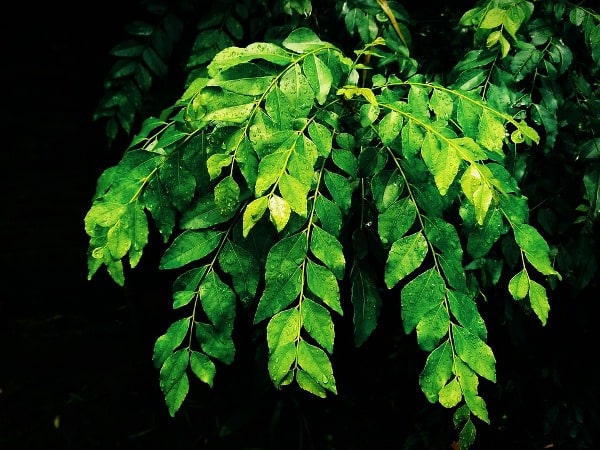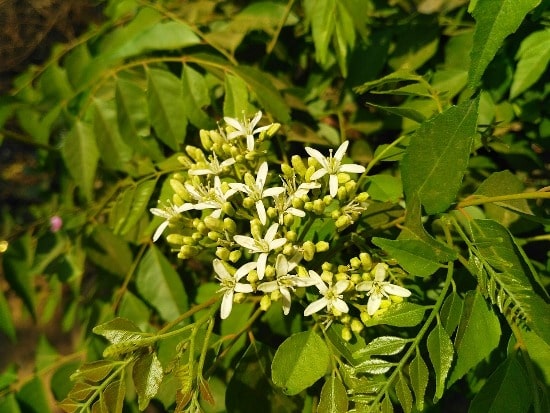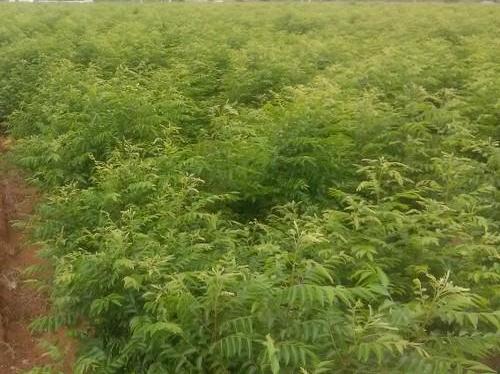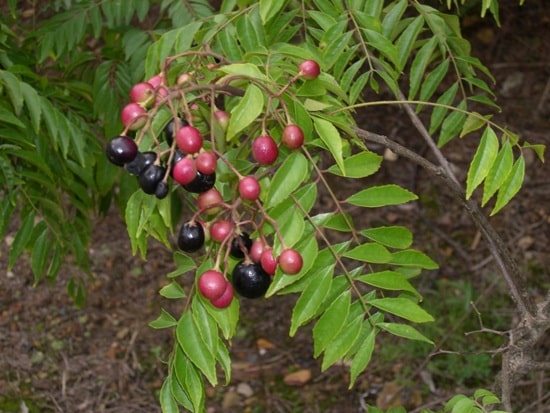Introduction to Curry Leaf plants
The following information is about the Curry Leaf Farming Project Report.
Curry Leaf is the name given to Murraya Koenigii in the Indian Dialects. This plant is well-known for its high medicinal values and rich characteristic aroma. The plant is distributed and cultivated all over India but is known to grow in tropical and sub-tropical zones. The plant is considered a shrub, which is deciduous in nature. The Curry Leaf plant grew naturally in the forests and wastelands of the Indian Subcontinent but is now known to be cultivated in Srilanka, South East Asia, Australia and in the Pacific Islands. The Murraya genus is believed to have 14 global species, but only two of them are cultivated or found in India. They are Murraya Koenigii called as Spreng and Murraya Paniculata called as Jack. All the parts of the plant are beneficial in making products, but the most economical part of the plant is the leaves, which are used in cuisines as flavoring agents.
Curry Leaf Plants have recently gained importance as commercial crops and are widely cultivated in the states of Tamil Nadu, Kerala, and Karnataka. These plants are also seen growing wild in the foothills of Himalayas from Kumaon to Sikkim. The cultivation has also extended to West Bengal, Assam, and the Deccan Plateau. Sometimes Curry Leaf plants are found as intercrops between other perennial crops.

The Curry Leaf farming project report describes the farming methods and requirements for successful development of the plant. At the end of the report, the details of cultivating Curry Leaf plants for an acre of land has been described for reference.
Properties of the plant and the leaf
The Curry Leaf plant is classified as an aromatic shrub having woody slender branches. The stem color is either green or brown and the height of the tree ranges in between 4 to 9 m approximately. The diameter of the trunk may be around 81 cm and the diameter of the main stem is about 16 cm.
The plant has small white funnel-shaped flowers with a diameter of 1.12 cm growing in clusters of around 60-90 flowers per cluster. The flower has five petals and 10 stamens. The flower of this plant has a sweet fragrance and is self-pollinating in nature.
The plant bears fruit in clusters of 32 to 80 fruits approximately. The shape of the fruit is ovoid and is green in color having one or two seeds enclosed in a thin pericarp. The diameter of the fruit is 1 to 1.2 cm and length is 1.4 to 1.6 cm. The fruit changes to purple-black color upon ripening. It is believed that the seeds of the plant are poisonous in nature and should not be consumed in any form.
The leaves are the main part of the plant that holds the aroma. These are shiny and smooth in texture. The underside of the leaf is pale in color. The base of the leaf is oblique and there are 11-21 leaflets on one small stem. The leaflets are arranged alternately on a short stalk with a petiole of 0.5 cm length.
The leaf of the plant is rich in organic compounds and the chemical composition shows the presence of alkaloids, flavonoids, carbohydrates, sterol, etc. The leaves of the plant contain moisture, proteins, carbohydrates (sugar) and some percentage of calcium, iron, and Beta-carotene. The flavor and aroma in the leaves are because of compounds like pinene, sabinene, caryophyllene, cardinal and cadinene. The leaf of the plant can be used in four different forms, i.e. fresh leaves, dried, powdered and cooked.
Varieties of Curry Leaves
This plant (Curry Leaf) exists in three different varieties:
Regular – the trees are tall and fast growing.
Dwarf – the trees are medium sized. The leaves are long and lighter in shade.
Gamthi – it is a slow-growing variety but has thick leaves with a rich aroma.
Other than these there are developed varieties such as Sen Kaampa, Dharwad-1, and Dharwad-2.
Soil and climate requirements for growing Curry leaf plants

There are no exclusive climatic conditions required for the cultivation of curry leaves. They are considered to grow in dry climates as well. The ideal temperature range for Curry Leaf farming is around 16-37˚C. The growth of the plant gets affected beyond these temperatures. Red sandy loam soil is suitable for its cultivation but should have good draining properties. It is also observed that this plant is not very particular about soil conditions or types; the only factor of plant growth is any light textured soil is suitable for the plant.
Propagation techniques of Curry leaves farming project report
The plant can be propagated through seeds or stem cuttings. The process of propagation is difficult with seeds but is the most commonly used method for farming Curry Leaf plants.
The seeds for planting are collected from mature fruits in the month of July-August and are sown in a well-prepared nursery bed for germination just before the onset of monsoon. Seeds that are fresh show high germination rate when compared to stored seeds. Seeds should not be over three days old for planting. The seedlings from the nursery are transferred to a pot, polythene bags or land with proper compost mixture. They should be transplanted into the main field only after they are one year old. The germination of seeds is unpredictable therefore it is not an easy task to handle and that is the reason people look for more consistent methods of farming. Also, is it observed that cultivation of Curry Leaf plants from the seeds takes longer time when compared to other methods of propagation.
The best and the easiest way of propagation of Curry Leaf plant is through stem cuttings. Stem with a petiole and leaf is obtained and planted for it to grow. The stem obtained from the tree should be around 3 inches long and should have several leaves. The leaves from the bottom of the stem up to one inch are removed and are inserted into a soilless medium for growing. Under warm and moist conditions the stem is expected to root in 3 weeks time. Once the plant is well rooted, it is then planted into the main area with rich compost and good fertilizer mixtures.
Land preparation and planting in curry leaves farming project report
The land chosen for the cultivation of Curry Leaf farming should be ploughed and harrowed at least two or three times to remove all the stones and stubbles from the area. Pits are marked and dug six months before transplanting the seedlings into the area. The dimensions of the pit are approximately 1.5 x 1.5 x 2 ft (for a hard ground area). The idea of leaving the pits open for six months is to fill them with leaves and well-rotted compost. The normal spacing between the plants should be around 90 to 120 cm. For normal soil conditions; pits of dimensions 30 x 30 x 30 cm are dug and are filled with topsoil, decomposed FYM at the time of planting. Furrows are created connecting all the pits such that irrigation could be made easy. The saplings are planted along with the mud mixture from the polythene bags in the main area during the monsoon.
Read: Growing Spinach In Containers, Pots, Indoors, Backyards.
Manure and fertilizer application for Curry leaf plants
Because the leaves of the plant are edible, it is not advisable to fertilize the plants with inorganic substances. The commercial methods of farming do sometimes use inorganic fertilizers of the NPK type for higher yields. Initially, each pit is filled with 15-25 kgs of compost at the time of planting. The nitrogen, phosphorous and potassium fertilizers required per plant are 100 grams, 80 grams, and 60 grams respectively. The same quantity of fertilizers is applied at the end of the monsoon. During the second year of growth, each plant needs 250 grams of nitrogen, 100 grams of phosphorous and 80 grams of potassium. The entire amount of fertilizers is applied to the plants in two split dozes i.e. one at before the monsoon and another after the monsoon. Along with these, additional quantities of around 10-15 kg of compost is given to the plants. Light irrigation is recommended after each fertilization cycle. Bio-fertilizers (Panchakavya) are most recommended for this plant to maintain the quality of the produce. It is also a recommended practice to spray salt water over the plants once in two or three weeks such that the plants remain healthy.
Irrigation requirements for Curry leaf plants
Conserving moisture in the soil is extremely important while cultivating Curry Leaf Plants. Since the seedlings are planted just before the monsoon, much irrigation is not required immediately, but if the area is not rainfed the irrigation arrangements have to be done. Each plant should be irrigated with a 3 to a 5-day interval in a non-rainfed area for better growth. After 3 years of planting, the plants should be irrigated at an interval of 15 days. The modern way of irrigating the plants through Fertigation technique has shown higher yield in the plants probably due to stable moisture and nutrient content maintained at the root zone of the plant. Frequent nutrient application and irrigation at shorter intervals are believed to show a great difference in plant growth and yield.
Intercultural practices of Curry leaves cultivation

Hoeing is done during the rainy season and at the end of winter in the initial years of planting to remove the weeds. Mulching with straw is also a beneficial practice to retain soil moisture in the farming area.
Intercropping with pulses is generally done during the initial years of planting. The dry plants of the pulses are used as mulch for the farm.
Topping the plant up to 100 cm height is done to encourage maximum leaf production. Doing so helps in branch development on all sides. Pruning the branches after a certain interval of time also encourages leaf development. Pruning or topping of the plant should be followed by nutrient application and light irrigation so as to facilitate heavy growth of leaves. Pruning of the plant is done such that the plant assumes a proper shape and all parts of the plant receive sufficient sunlight. Generally, 5-6 branches are maintained per bush. The plants should never be allowed to flower until and unless it is required otherwise flowering and fruit development drastically reduces the quality of the leaves.
Disease and pest management of Curry leaves cultivation
The most common pests of the Curry Leaf plant are a citrus butterfly, psyllid bug and scale and other soil-borne pests. The disease commonly found in the Curry Leaf plants is leaf spot. These plants are less prone to diseases and pests when under proper maintenance. Even before the infestation by the pests, it is recommended to use tobacco decoction as a preventive spray to reduce the chances of occurrence. Soil-borne diseases can be controlled by using neem cake @ 1-2 kgs per plant once in a year. An alternate treatment could be spraying herbal insecticides on the plants during the morning hours, especially before the winter season.
Harvesting and yield in curry leaf farming project report
The first harvest can be done after 10-12 months of planting and the yield is generally lower during the first year but increases every subsequent year. Pruning and topping are methods of harvesting the plants. After the second year of planting, harvesting of curry leaves is carried out thrice in a year. It is estimated that in the first year around 400 kg of leaves are obtained per hectare of land, 5400 kg in the second and third year, 10, 000 kg in the fourth year and so on until 25 years. Once planted the Curry Leaf tree can survive for 20-25 years on an average under proper maintenance. The leaves are then graded according to their size and quality. Preparation of volatile oil from the leaves is one of the post-harvest management techniques followed after farming.
When the leaves are distilled under superheated steam at about 220˚C then dark, foul-smelling oil is obtained. This essential oil after refining looks light yellow in color with a spicy aromatic smell.
Cost and profit analysis / Economics of Curry Leaf Farming / Curry Leaf Farming Project Report

The estimation for farming curry leaves on one acre of land is being discussed here. The values in the report are to be taken as a reference because the original price of the raw materials may deviate slightly from these figures due to various factors like location, availability, size of the farm etc.
Assumptions of curry leaf farming project report:
Cost of Curry Leaf plant: Rs 25 per piece.
Labor cost per day: Rs 250 (average).
| Requirement | Investment in Rs |
| Land preparation and planting (includes labor cost for 2 laborers) | 5000.00 |
| Labour for fertilizer application, weeding, mulching, pruning and irrigation | 50,000.00 |
| Labour required for Harvesting the leaves | 30,000.00 |
| Cost of fertilizers | 15,000.00 |
| Cost of farmyard manure | 12,000.00 |
| Installation of irrigation system (drip system) | 55,000.00 |
| Cost of planting material per acre @ 3000 saplings per acre. | 75,000.00 |
| Total investment | 2,62,000.00 |
The sale price of curry leaves: Rs 30 per kg.
The average annual yield from a plant: 10 tonnes or 10000 kgs (may vary depending on the external and maintenance factors).
Income from the farm annually is Rs 3, 00,000 (Three lakhs rupees).
Profit from the curry leaf farming is Rs 38,000 (after 2 years of planting).
This yield is expected only after two years of planting and then profits start coming in. At the end of the first year the yield is low around 400 to 500 kgs and in the subsequent year it increases to 1500 kgs and there could be a possibility of 2 or 3 harvests in the second year of planting. Similarly, the yield further increases and harvesting the plant is done once in three months after 3 years of planting. It is important to note that the analysis has not considered the charges for land rent, transport, electricity for irrigation and other miscellaneous costs that may be present during farming, but while the practical deployment of the project all these aspects have to be considered depending on the area of the farm and its location.
Loans and subsidies for Curry Leaf Farming Project Report
The National Horticulture Board develops several schemes to assist farmers on different varieties of crops. It is suggested that anyone interested in Curry Leaf farming could visit the local Horticulture Board office or their website to get detailed information on updated schemes and policies.
NABARD also finances farmers for starting an agriculture business, but it largely depends on the type of project one selects. So, visiting the nearest NABARD service center along with a detailed project report can help farmers get the required assistance in the form of loans or subsidies. Please note that NABARD has policies outlined differently for different states.
Tips for maintaining Curry Leaf plants

If curry leaf plants are being grown as a garden plant then it is highly important to take extra care during the winter season when there is a greater risk of plant diseases. Some useful tips for proper maintenance are:
- The plants should be placed under the sun in the morning and moved indoors to avoid extreme cold conditions.
- When cultivated in areas with freezing temperatures, then warm water is supplied to the plants instead of normal water.
- Sprinkling salt water occasionally on the leaves can keep away bugs, mites, and mold from the plants.
- If they are potted indoors then sufficient light and airflow is a must for its growth.
- Under extremely cold conditions cover the plants with black trash bags and secure them with sticks around the pot. This keeps the plant warm.
- Never expose the Curry Leaf plants to frost and freezing temperatures.
Read Types Of Mulching.
Read Prawn Cultivation.
Hi There,
This is Naveen. I need to know all about “aloe vera” project. What are all the basic requirement need to farming aloe vera in 2 acres of land. And what are all the deceases will occur to this plant and how to control it.
How much cost it will take for this project.
Who are all the vendor and customer, how to find them.
You can read the Aloe Vera Information at: ALOE VERA FARMING PROJECT REPORT.
i am intrested in curry leaf farming so give detail for best market in india